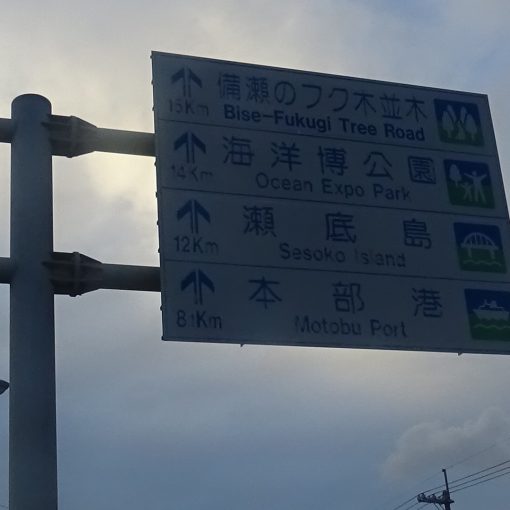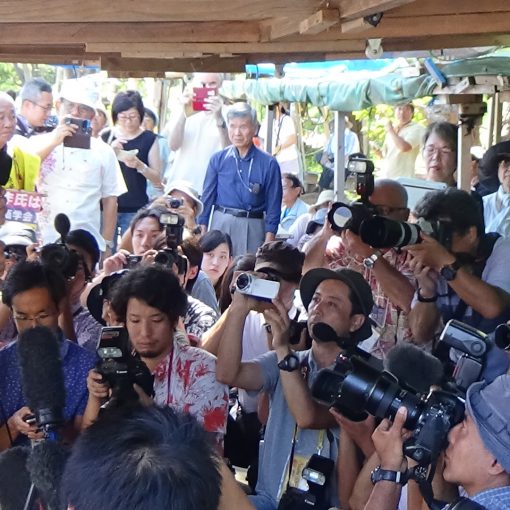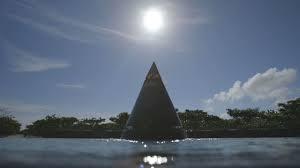November 1, 2019 Ryukyu Shimpo
Shuri Castle has burned down.
This treasure in the hearts of Okinawans which was rebuilt after its destruction in the Battle of Okinawa by the efforts of a large number of people committed to restoring the symbol of the Ryukyu Kingdom destroyed in the Battle of Okinawa, was reduced to ash in a single night.
This helpless scene has enveloped all of Okinawa in a grief as if they have been torn apart, and a sense of loss.
The loss of Okinawa’s greatest cultural asset is of incalculable magnitude.
However, we cannot be overcome with grief. In order to once again restore this vibrant crimson figure, Okinawans have to combine their strength to rebuild.
Shuri Castle, which embodied the history of the Ryukyu Kingdom, was the center of politics and culture as the seat of the emperor.
The main building was the center of diplomacy and trade for all of the countries in Asia as an independent country that had ties to all of the major powers in Asia, exemplified by the “Bridge of Nations Bell”, which has an inscription on the side that that includes the statement, “Journeying to various countries by ship, [the Ryukyu Kingdom] forms a bridge between all the nation, filling its land with the previous goods and products of foreign lands.”
More recently, it has passed through a history of hardships that includes the fall of the Ryukyu Kingdom.
In 1879, Michiyuki Matsuda sent soldiers from the Kumamoto Garrison to occupy Shuri Castle and expel the king of the Ryukyus, establishing the Kumamoto Garrison in the castle in the process.
Then, despite being designated a national treasure in 1925, in the 32nd Army of the Japanese Imperial Forces had established their command underneath the castle, which was then completely destroyed by U.S. bombardment during the Battle of Okinawa.
Restoring the lost cultural asset was a project that was met with a large number of difficulties.
Using documents and photos, the techniques of the time were recreated for each tile and pillar, and historians, artists, and engineers combined their wisdom to complete the restoration.
The rebuilding of Shuri Castle was recognized as the restoration of Okinawa history and culture by the people of Okinawa.
It strengthened the Uchinanchu identity, and was a source of pride. In 2000, the castle hosted a dinner for the G8, and was registered as a World Cultural Heritage site, announcing Okinawa’s bridge to the new generation to the international community.
The main hall, the southern and northern hall, and all of the major facilities have been lost to the fire.
What has become of the cultural assets that were exhibited there?
It is a grave concern. Okinawa had only just received permission from the Japanese government to manage the castle themselves in February.
It brings into question the responsibility of the prefecture.
What was the cause of the fire?
Were there deficiencies in the management conditions and fire prevention processes?
We must determine the cause of the fire as well as investigate how to prevent damage to cultural assets.
It is vital that we thoroughly investigate how to ensure that Okinawa’s precious cultural asset is not lost to fire a second time.
Including its destruction in the Battle of Okinawa, Shuri Castle has been destroyed four times throughout history. It has been rebuilt each time.
Thankfully, the successes of the previous restoration project, which began 30 years ago, remain.
If the system is set up properly, it is entirely possible that Shuri Castle can once again be resurrected.
When Notre Dame was similarly destroyed in a fire, and when Kumamoto Castle was destroyed in the Kumamoto earthquake, donations and support came pouring in almost immediately, and people set to work rebuilding. We can overcome the Shuri Castle fire this time as well.
(English translation by T&CT and Sam Grieb)





